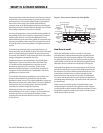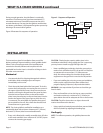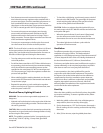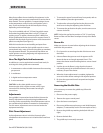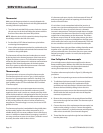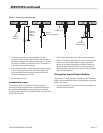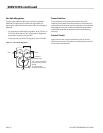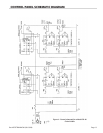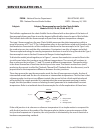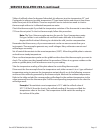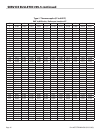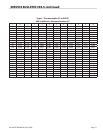
Part #GCGTRAINING06 (03/03/08))Page 14
SERVICE BULLETIN #95-5
FROM – National Service Department BULLETIN NO. #95-5
TO – National Service Binder Holders DATE – February 24, 1995
Subject: Subject: Thermocouples used in the Chain Griddle
Models CG-36, CG-48, CG-60 & CG-72
This bulletin supplements the chain Griddle Service Manual with a description of the basics of
thermocouple theory and how to use the degree/millivolt tables issued as part of this bulletin.
This bulletin deals with the thermocouple only and how it registers temperature changes.
The type J thermocouple on the new Chain Griddle measures the plate temperature within a
range of accuracy of 2˚F to 4˚F. The J designation refers to the conductors used and, therefore, the
thermoelectric characteristics of the conductors that form the thermocouple. In the Type J unit,
the conductors are iron and the alloy constantan. Constantan is an alloy of copper and nickel.
Thermocouple technology for sensing temperature has been in use for a long time but the Type J
thermocouple is new to Garland Commercial Ranges Limited applications.
To dissimilar metals joined together, as in Figure 1, cause a thermoelectric current to ow in the
circuit formed when the junctions are at dierent temperatures. The current will continue to
ow as along as the junctions (T1 and T2) remain at dierent temperatures. Thermoelectricity
is the direct conversion of heat into electricity and vice versa. The electric motive force (emf)
producing the current is called the “Seebeck Thermal Emf” (Seebeck after the discoverer), and is
proportional to the temperature dierence between the two junctions.
Three laws govern the way thermocouples work: the law of homogeneous circuits, the law of
intermediate metals and the law of successive or intermediate temperatures. The rst law is that
a thermocouple circuit must use dierent metals; the second is that a third metal introduced
will not aect the couple provided it is maintained at the same temperature along its entire
length; the third provides a means of relating the emf generated to a standardized constant
temperature. Refer to a textbook about thermocouples for a fuller explanation of these laws.
Metal A
T
1 junction
T
2 junction
T = Temperature
I = Current
V = Voltage (emf)
Metal BMetal B
Figure 1
V
I
If the cold junction is at a known or reference temperature it is a simple matter to compare this
with the hot junction at the probe of the thermocouple to obtain an accurate measure of the
hot junction temperature. In practice, the cold junction is eliminated by the use of electrical or
hardware compensating methods.



